Distinct Proteomic Signatures in 16 HDL (High-Density Lipoprotein) Subspecies
- PMID: 30571168
- PMCID: PMC6309805
- DOI: 10.1161/ATVBAHA.118.311607
Distinct Proteomic Signatures in 16 HDL (High-Density Lipoprotein) Subspecies
Abstract
Objective- HDL (high-density lipoprotein) in plasma is a heterogeneous group of lipoproteins typically containing apo AI as the principal protein. Most HDLs contain additional proteins from a palate of nearly 100 HDL-associated polypeptides. We hypothesized that some of these proteins define distinct and stable apo AI HDL subspecies with unique proteomes that drive function and associations with disease. Approach and Results- We produced 17 plasma pools from 80 normolipidemic human participants (32 men, 48 women; aged 21-66 years). Using immunoaffinity isolation techniques, we isolated apo AI containing species from plasma and then used antibodies to 16 additional HDL protein components to isolate compositional subspecies. We characterized previously described HDL subspecies containing apo AII, apo CIII, and apo E; and 13 novel HDL subspecies defined by presence of apo AIV, apo CI, apo CII, apo J, α-1-antitrypsin, α-2-macroglobulin, plasminogen, fibrinogen, ceruloplasmin, haptoglobin, paraoxonase-1, apo LI, or complement C3. The novel species ranged in abundance from 1% to 18% of total plasma apo AI. Their concentrations were stable over time as demonstrated by intraclass correlations in repeated sampling from the same participants over 3 to 24 months (0.33-0.86; mean 0.62). Some proteomes of the subspecies relative to total HDL were strongly correlated, often among subspecies defined by similar functions: lipid metabolism, hemostasis, antioxidant, or anti-inflammatory. Permutation analysis showed that the proteomes of 12 of the 16 subspecies differed significantly from that of total HDL. Conclusions- Taken together, correlation and permutation analyses support speciation of HDL. Functional studies of these novel subspecies and determination of their relation to diseases may provide new avenues to understand the HDL system of lipoproteins.
Keywords: apolipoproteins; cardiovascular diseases; enzyme-linked immunosorbent assay; humans; lipoproteins, HDL; peptides; proteomics.
Figures

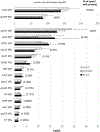
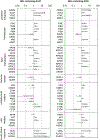
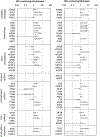


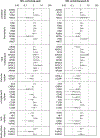
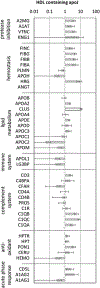
References
Publication types
MeSH terms
Substances
Grants and funding
LinkOut - more resources
Full Text Sources
Research Materials
Miscellaneous

